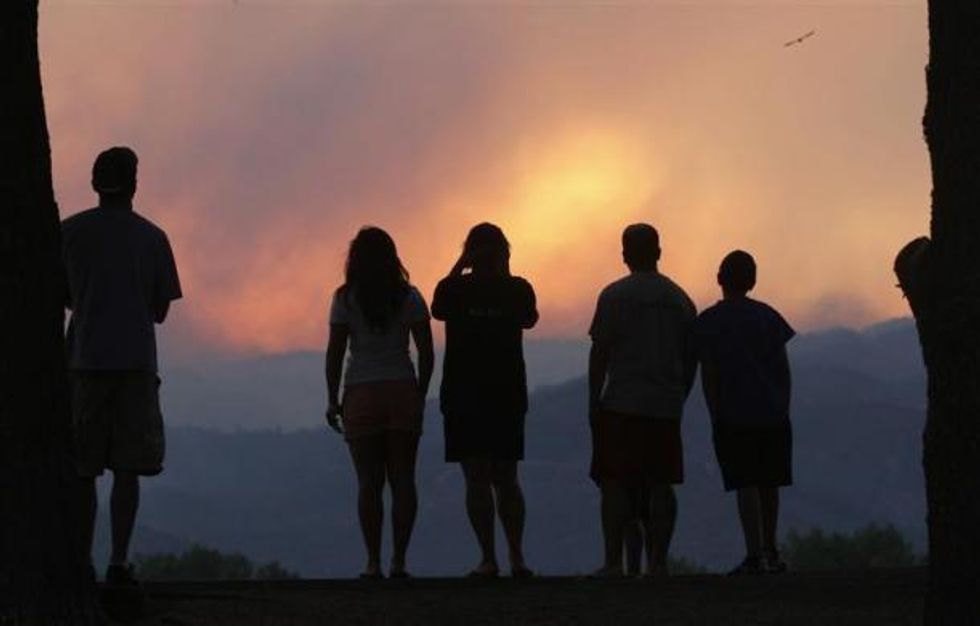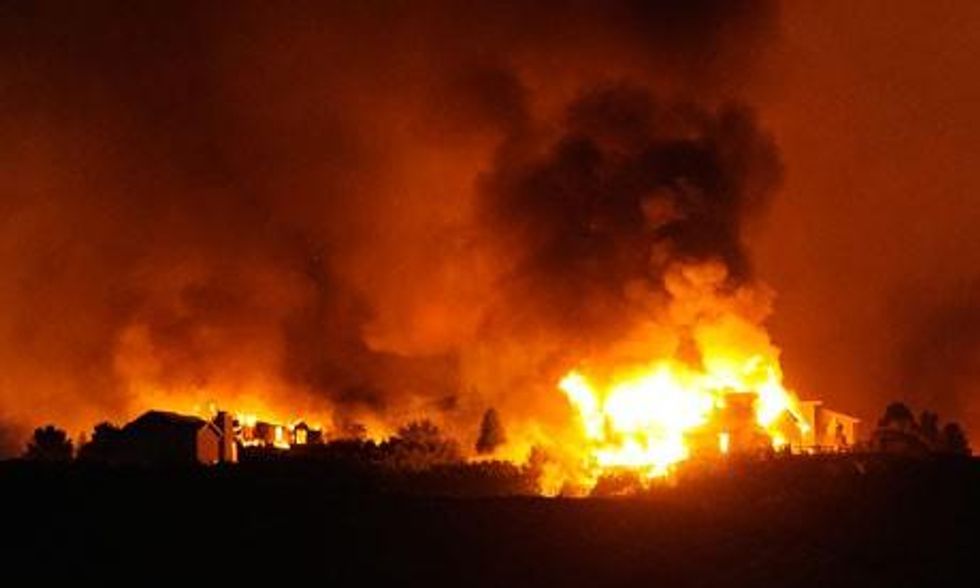'Heat... Fire... Disaster': What Climate Change Looks Like
Western US fires are being driven by extreme temperatures, which are consistent with IPCC projections

Oppenheimer, speaking alongside other scientists, argued that shorters winters with less snow, coupled with earlier Springs, and extreme summer heat -- all contributors for the fires burning in Colorado, Wyoming, and New Mexico -- were also conditions that he and his colleagues at the U.N. Intergovernmental Panel on Climate Change (IPCC) predicted would result from carbon-induced climate change.
According to "Heat Waves and Climate Change," a new report from Climate Communication, a nonprofit science outreach group which, along with Climate Nexus, coordinated the conference call with Oppenheimer and others, the "remarkable run of record-shattering heat waves in recent years, from the Russian heat wave of 2010 that set forests ablaze to the historic heat wave in Texas in 2011 and the "Summer in March" in the U.S. Midwest in 2012" all typify the ongoing trend driven by climate change.

The stage was set for these fires when winter snowpack was lighter than usual, said Dr. Steven Running, a forest ecologist at the University of Montana, reports Reuters. Mountain snows melted an average of two weeks earlier than normal this year, Running said. "That just sets us up for a longer, dryer summer. Then all you need is an ignition source and wind."
"Now we have a lot of dead trees to burn ... it's not even July yet," he said. Trying to stop such blazes driven by high winds is a bit like to trying to stop a hurricane, Running said: "There is nothing to stop that kind of holocaust."
Since 1950 the number of heat waves worldwide has increased, and heat waves have become longer, according to the new report. In the most recent years, it continues, "the global area hit by extremely unusual hot summertime temperatures has increased 50-fold. Over the contiguous United States, new record high temperatures over the past decade have consistently outnumbered new record lows by a ratio of 2:1. In 2012, the ratio for the year through June 18 stands at more than 9:1. Though this ratio is not expected to remain at that level for the rest of the year, it illustrates how unusual 2012 has been, and how these types of extremes are becoming more likely."
Dr. Running, quoted by the New York Times, said that with human-induced climate change, extreme events will become ever more prevalent.
"We're just upping the odds that wildfire activity is going to accelerate every year with the warming trends we see," he said.
# # #
An Urgent Message From Our Co-Founder
Dear Common Dreams reader, The U.S. is on a fast track to authoritarianism like nothing I've ever seen. Meanwhile, corporate news outlets are utterly capitulating to Trump, twisting their coverage to avoid drawing his ire while lining up to stuff cash in his pockets. That's why I believe that Common Dreams is doing the best and most consequential reporting that we've ever done. Our small but mighty team is a progressive reporting powerhouse, covering the news every day that the corporate media never will. Our mission has always been simple: To inform. To inspire. And to ignite change for the common good. Now here's the key piece that I want all our readers to understand: None of this would be possible without your financial support. That's not just some fundraising cliche. It's the absolute and literal truth. We don't accept corporate advertising and never will. We don't have a paywall because we don't think people should be blocked from critical news based on their ability to pay. Everything we do is funded by the donations of readers like you. Will you donate now to help power the nonprofit, independent reporting of Common Dreams? Thank you for being a vital member of our community. Together, we can keep independent journalism alive when it’s needed most. - Craig Brown, Co-founder |

Oppenheimer, speaking alongside other scientists, argued that shorters winters with less snow, coupled with earlier Springs, and extreme summer heat -- all contributors for the fires burning in Colorado, Wyoming, and New Mexico -- were also conditions that he and his colleagues at the U.N. Intergovernmental Panel on Climate Change (IPCC) predicted would result from carbon-induced climate change.
According to "Heat Waves and Climate Change," a new report from Climate Communication, a nonprofit science outreach group which, along with Climate Nexus, coordinated the conference call with Oppenheimer and others, the "remarkable run of record-shattering heat waves in recent years, from the Russian heat wave of 2010 that set forests ablaze to the historic heat wave in Texas in 2011 and the "Summer in March" in the U.S. Midwest in 2012" all typify the ongoing trend driven by climate change.

The stage was set for these fires when winter snowpack was lighter than usual, said Dr. Steven Running, a forest ecologist at the University of Montana, reports Reuters. Mountain snows melted an average of two weeks earlier than normal this year, Running said. "That just sets us up for a longer, dryer summer. Then all you need is an ignition source and wind."
"Now we have a lot of dead trees to burn ... it's not even July yet," he said. Trying to stop such blazes driven by high winds is a bit like to trying to stop a hurricane, Running said: "There is nothing to stop that kind of holocaust."
Since 1950 the number of heat waves worldwide has increased, and heat waves have become longer, according to the new report. In the most recent years, it continues, "the global area hit by extremely unusual hot summertime temperatures has increased 50-fold. Over the contiguous United States, new record high temperatures over the past decade have consistently outnumbered new record lows by a ratio of 2:1. In 2012, the ratio for the year through June 18 stands at more than 9:1. Though this ratio is not expected to remain at that level for the rest of the year, it illustrates how unusual 2012 has been, and how these types of extremes are becoming more likely."
Dr. Running, quoted by the New York Times, said that with human-induced climate change, extreme events will become ever more prevalent.
"We're just upping the odds that wildfire activity is going to accelerate every year with the warming trends we see," he said.
# # #

Oppenheimer, speaking alongside other scientists, argued that shorters winters with less snow, coupled with earlier Springs, and extreme summer heat -- all contributors for the fires burning in Colorado, Wyoming, and New Mexico -- were also conditions that he and his colleagues at the U.N. Intergovernmental Panel on Climate Change (IPCC) predicted would result from carbon-induced climate change.
According to "Heat Waves and Climate Change," a new report from Climate Communication, a nonprofit science outreach group which, along with Climate Nexus, coordinated the conference call with Oppenheimer and others, the "remarkable run of record-shattering heat waves in recent years, from the Russian heat wave of 2010 that set forests ablaze to the historic heat wave in Texas in 2011 and the "Summer in March" in the U.S. Midwest in 2012" all typify the ongoing trend driven by climate change.

The stage was set for these fires when winter snowpack was lighter than usual, said Dr. Steven Running, a forest ecologist at the University of Montana, reports Reuters. Mountain snows melted an average of two weeks earlier than normal this year, Running said. "That just sets us up for a longer, dryer summer. Then all you need is an ignition source and wind."
"Now we have a lot of dead trees to burn ... it's not even July yet," he said. Trying to stop such blazes driven by high winds is a bit like to trying to stop a hurricane, Running said: "There is nothing to stop that kind of holocaust."
Since 1950 the number of heat waves worldwide has increased, and heat waves have become longer, according to the new report. In the most recent years, it continues, "the global area hit by extremely unusual hot summertime temperatures has increased 50-fold. Over the contiguous United States, new record high temperatures over the past decade have consistently outnumbered new record lows by a ratio of 2:1. In 2012, the ratio for the year through June 18 stands at more than 9:1. Though this ratio is not expected to remain at that level for the rest of the year, it illustrates how unusual 2012 has been, and how these types of extremes are becoming more likely."
Dr. Running, quoted by the New York Times, said that with human-induced climate change, extreme events will become ever more prevalent.
"We're just upping the odds that wildfire activity is going to accelerate every year with the warming trends we see," he said.
# # #

